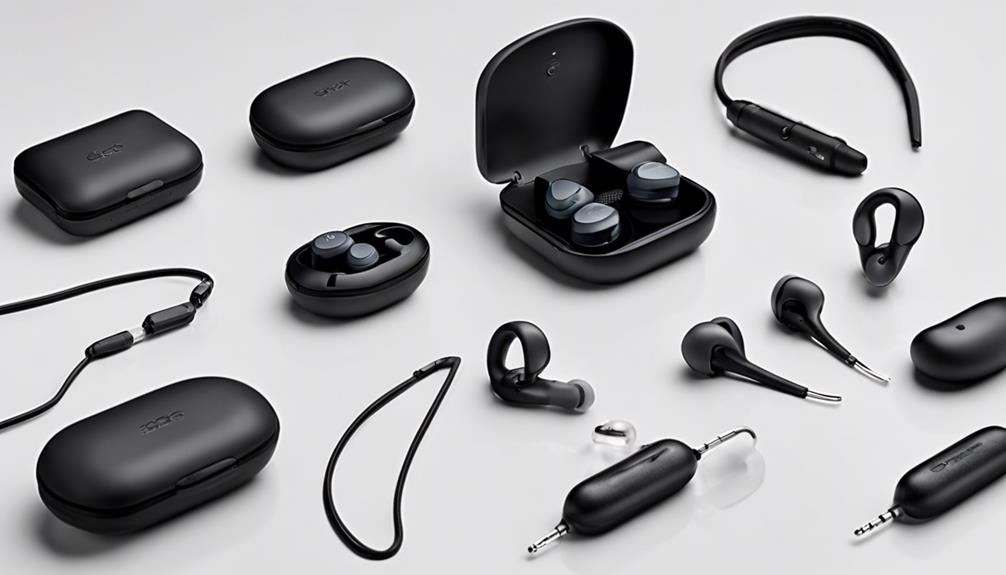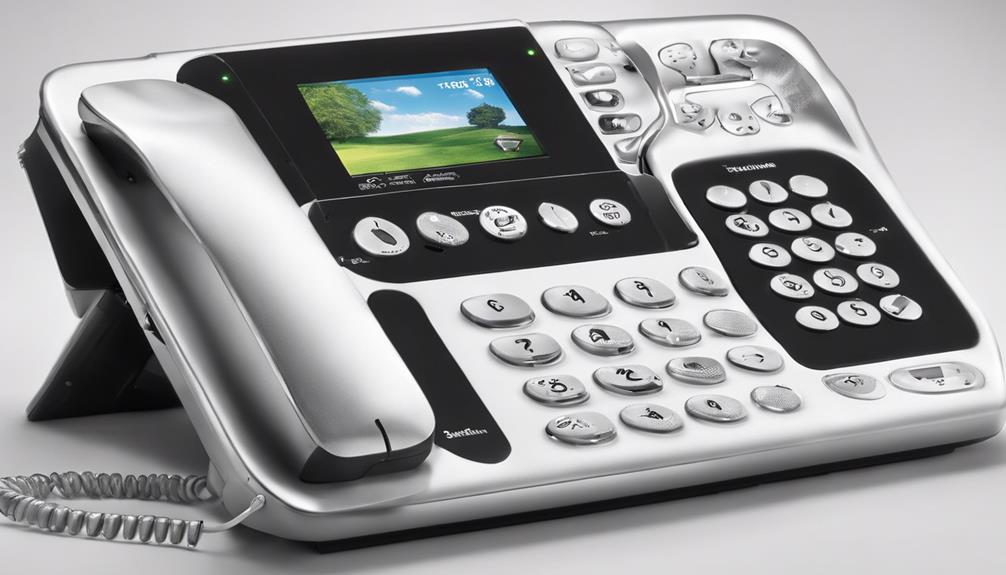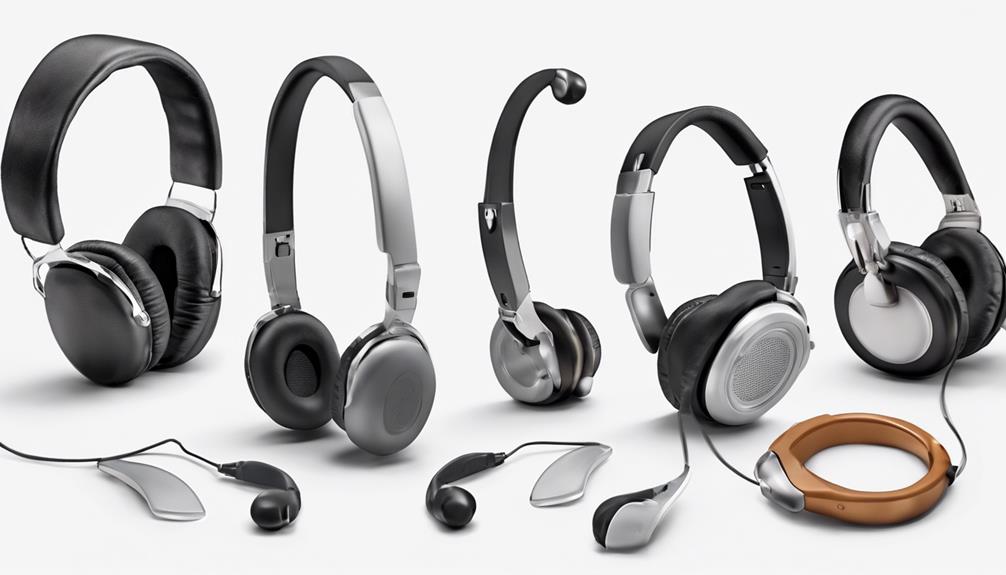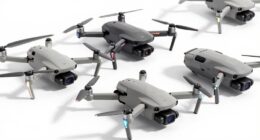Exploring the world of assistive hearing devices can lead to discovering innovative solutions created to enhance the quality of hearing.
From specialized alarm systems with unique features to communication devices that revolutionize phone conversations, the top 7 listening assistive devices offer a diverse range of benefits for individuals with hearing difficulties.
Stay tuned to discover how these devices can transform everyday interactions and environments, making sound more accessible and enjoyable for those who rely on them.
Key Takeaways
- Hearing aids offer personalized amplification for individuals with different types of hearing loss.
- Audio enhancement systems like TV listening systems provide clear sound transmission without disturbance.
- Wireless connectivity devices such as Bluetooth hearing devices enhance audio streaming directly to the user's ears.
- FM systems improve communication clarity and reduce distractions in noisy environments like classrooms and meetings.
Hearing Aids
Hearing aids, essential devices for individuals with hearing loss, come in various types such as behind-the-ear (BTE), in-the-ear (ITE), and completely-in-the-canal (CIC) styles. These assistive listening devices are designed to amplify sounds for people with hearing loss, enabling them to communicate effectively and engage in daily activities. Individuals with hearing loss benefit from the advanced technology integrated into modern hearing aids, such as Bluetooth connectivity, noise reduction features, and directional microphones that enhance sound quality.
Audiologists play a crucial role in customizing hearing aids to meet the specific needs and preferences of users. Regular maintenance, cleaning, and professional adjustments are vital to ensure that hearing aids perform optimally. By working closely with audiologists, individuals can receive personalized care to address their unique hearing requirements, ultimately enhancing their quality of life. With the right type of hearing aid and proper care, people with hearing loss can experience improved auditory experiences and better communication outcomes.
Personal Amplifiers

With personal amplifiers becoming increasingly popular as assistive listening devices, what sets these devices apart in terms of enhancing sound clarity and reducing background noise? Personal amplifiers, such as the Williams Sound Pocketalker 2.0 and the Reizen Loud Ear Hearing Enhancer, are designed to cater to various types of hearing loss, offering superior sound quality while minimizing background noise interference. These devices feature ergonomic and lightweight designs for comfortable use and easy portability. One key advantage of personal amplifiers is the ability for users to adjust volume settings to suit their individual preferences, ensuring a personalized listening experience. These devices can amplify sound up to 110dB, significantly improving voice clarity and overall sound quality. Additionally, personal amplifiers like the Reizen Loud Ear Hearing Enhancer come equipped with built-in microphones and long-range capabilities, providing up to 48 hours of battery life for extended use.
| Features | Benefits |
|---|---|
| Ergonomic Design | Comfortable and easy to use |
| Adjustable Volume | Personalized listening experience |
| Superior Sound Quality | Enhanced voice clarity and reduced background noise interference |
TV Listening Systems
TV Listening Systems encompass various devices like wireless TV headphones, hearing loop systems, and TV soundbars that enhance sound quality and clarity for individuals with hearing difficulties.
These systems utilize radio frequency technology to transmit audio signals directly to the listener, providing a customized listening experience without disturbing others.
Wireless TV Headphones
Utilizing advanced radio frequency technology, wireless TV headphones deliver personalized audio directly to the headset, ensuring a comfortable and clear TV watching experience.
- Wireless TV headphones utilize radio frequency technology to amplify and enhance TV audio.
- The transmitter box sends audio signals wirelessly, allowing for personalized sound levels without disturbing others.
- Ideal for individuals with hearing difficulties, providing a comfortable and private TV watching experience.
- Users can adjust the volume to their preference without affecting others in the room.
These headphones offer a convenient solution for individuals seeking clear, private TV audio without the need for excessively loud volume levels, making TV watching more enjoyable for those with hearing impairments.
Hearing Loop Systems
Hearing loop systems, also known as TV listening systems, utilize electromagnetic energy to directly transmit clear sound to users' telecoil receivers, effectively eliminating background noise for individuals with mild to moderate hearing loss. These assistive devices are ideal for various settings, such as theaters, churches, and public venues, where sound levels can often be challenging for those with hearing impairments.
Many hearing aids and cochlear implants come equipped with telecoils, allowing users to easily access and benefit from hearing loop systems. By switching their hearing devices to the 'T Setting,' individuals can enjoy improved auditory experiences in environments equipped with hearing loop technology.
TV Soundbars
Enhancing audio clarity for individuals with hearing loss during television viewing can be achieved through the use of TV soundbars. These devices offer improved sound quality, speech intelligibility, and immersive audio experiences. They can be connected directly to the TV or wirelessly for convenience. Some models feature dialogue enhancement technology to emphasize voices for better understanding. TV soundbars are compact, easy to install, and provide a more enjoyable TV viewing experience for users.
- Enhanced sound quality
- Speech intelligibility improvement
- Convenient wireless connectivity
- Dialogue enhancement technology
Bluetooth Hearing Devices

Wireless Bluetooth hearing devices seamlessly connect to smartphones, TVs, and other devices, allowing for high-quality audio streaming directly to the user's ears. By harnessing Bluetooth technology, these hearing devices deliver clear sound with minimal interference. They provide wireless connectivity that enhances the user's audio experience, whether for phone calls, music, or TV shows.
Compatible with various hearing aid models and cochlear implants, Bluetooth hearing devices cater to a wide range of users with hearing loss, offering personalized settings and control options. Utilizing smartphone apps or dedicated remote controls, users can easily adjust volume levels and customize their listening preferences.
These devices play a crucial role in helping individuals with hearing impairments enjoy improved clarity and comfort in diverse listening environments. With Bluetooth hearing devices, users can stay connected and engaged with the world around them through seamless audio streaming and advanced connectivity features.
Infrared Listening Systems

Building upon the seamless connectivity of Bluetooth hearing devices, the focus now shifts to Infrared Listening Systems, which transmit sound wirelessly using invisible light beams. These assistive technologies are highly effective in various indoor settings like theaters, churches, and conference rooms where background noise can often disrupt clear sound reception.
Here are some key points about Infrared Listening Systems:
- Infrared listening systems utilize invisible light beams to transmit sound wirelessly.
- They're particularly well-suited for indoor environments such as theaters, churches, and conference rooms.
- These systems offer clear sound reception, minimizing interference from background noise.
- Specialized devices are available for home TV listening, enhancing the viewing experience with infrared technology.
FM Assistive Listening Devices

FM assistive listening devices utilize radio waves to transmit sound wirelessly, offering enhanced clarity in various settings. These systems are widely employed in group environments such as classrooms, meetings, and religious congregations.
With the ability to reduce background noise and adapt to different locations, FM devices ensure improved auditory experiences for individuals seeking clearer sound.
FM Technology Overview
When considering assistive listening devices, one can't overlook the significant impact of FM technology in enhancing sound clarity and communication for individuals with hearing loss.
FM technology in assistive listening devices transmits sound wirelessly via radio waves, providing clearer audio reception. These systems are commonly used in group meetings, churches, and classes to eliminate background noise and ensure that users receive the intended audio signal effectively.
They're versatile, suitable for both indoor and outdoor settings, offering flexibility and accessibility. FM assistive listening devices stand out as a reliable solution for improving sound clarity and understanding in various environments.
Benefits of FM Systems
Enhancing communication clarity and sound reception, FM assistive listening devices revolutionize auditory experiences for individuals with hearing loss in various settings.
FM systems, which utilize radio waves, offer a direct wireless transmission of sound, particularly beneficial in environments with background noise. These assistive listening devices are commonly employed in classrooms, churches, and meetings, enhancing communication by reducing the impact of surrounding distractions.
By establishing a clear connection between the speaker's microphone and the listener's receiver, FM systems ensure that individuals with hearing loss can better understand and engage with their surroundings.
The portability and adaptability of FM systems make them versatile for use indoors and outdoors, providing improved auditory support in a range of situations.
Popular FM Models
Among the array of assistive listening devices available, several popular models stand out for their effectiveness in transmitting clear sound wirelessly in various settings.
When it comes to FM systems, these devices are highly sought after for their ability to provide exceptional sound quality in group settings like classrooms, meetings, and churches. The portability of FM models makes them convenient for users who require seamless audio transmission indoors and outdoors.
Additionally, FM systems are known for their compatibility with hearing aids and cochlear implants, enhancing the overall listening experience. Whether in a classroom or a crowded event, FM assistive listening devices offer reliability and clarity, making them a top choice for individuals seeking improved auditory support.
Captioned Telephones

Captioned telephones, equipped with real-time captioning features, are valuable tools that provide individuals with hearing loss the ability to read captions during phone conversations for improved communication clarity. These phones offer features such as adjustable font sizes, volume control, and speakerphone options to cater to individual needs. They're designed to enhance accessibility for those with hearing difficulties, ensuring that communication barriers are minimized.
Additionally, captioned telephones can be obtained at no cost with professional approval and are compatible with hearing aids, making them a practical solution for many individuals. By allowing users to easily read captions while on calls, these devices play a crucial role in facilitating effective communication.
Frequently Asked Questions
Are There Any Assistive Devices Specifically Designed for Hearing Loss in Children?
Yes, there are assistive devices tailored for children with hearing loss. These devices cater to the unique needs of young individuals, providing clear sound amplification and enhanced auditory experiences.
From hearing aids with child-friendly designs to FM systems that improve speech comprehension in noisy environments, a range of options exists to support children in navigating their hearing challenges.
These innovative technologies play a crucial role in facilitating communication and learning for young individuals with hearing impairments.
Can These Listening Assistive Devices Be Used in Noisy Environments?
Yes, listening assistive devices can be used in noisy environments. These devices often come equipped with features like noise cancellation or directional microphones to help filter out unwanted sounds and focus on speech or desired sounds.
Studies show that in challenging listening situations, these devices can significantly improve speech understanding and communication. Therefore, utilizing these devices in noisy environments can greatly enhance our ability to hear and understand clearly.
How Do I Know Which Listening Assistive Device Is Right for Me?
When selecting a listening assistive device, we consider individual needs and preferences. Factors like hearing loss severity, lifestyle, and budget influence the choice.
Consult with an audiologist for a comprehensive assessment and device recommendations tailored to your specific requirements. Trial different devices to assess comfort, sound quality, and features that align with your listening goals.
Ultimately, the right device will enhance your listening experience in various environments and improve overall communication.
Are There Any Assistive Devices That Can Help With Tinnitus?
Yes, there are assistive devices that can help with tinnitus.
Devices like white noise machines, hearing aids with masking features, and sound therapy devices can provide relief by masking the ringing or buzzing sounds associated with tinnitus.
These devices work by introducing external sounds that help distract from or cover up the tinnitus noise, offering some degree of relief and improving overall quality of life for individuals experiencing tinnitus symptoms.
Can These Devices Be Used With Cochlear Implants or Other Hearing Implants?
Yes, these devices can typically be used with cochlear implants or other hearing implants. This compatibility allows for a more comprehensive approach to managing hearing challenges.
Conclusion
In conclusion, the use of listening assistive devices has significantly improved the auditory experience for individuals with hearing difficulties.
According to a recent study by the National Institute on Deafness and Other Communication Disorders, approximately 15% of American adults aged 18 and over report some trouble hearing.
These top 7 devices offer innovative solutions for clearer sound in various situations, enhancing communication and overall quality of life for those with hearing impairments.











